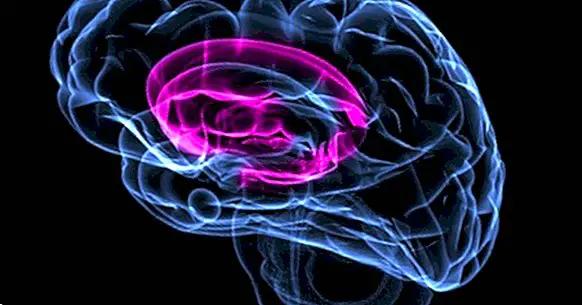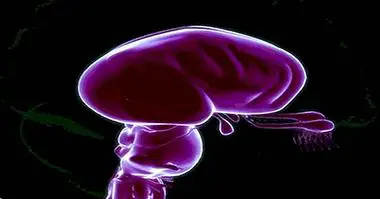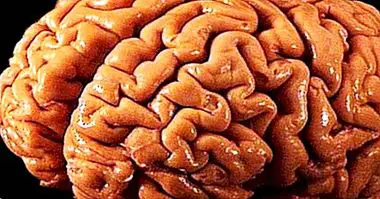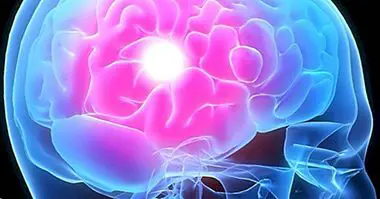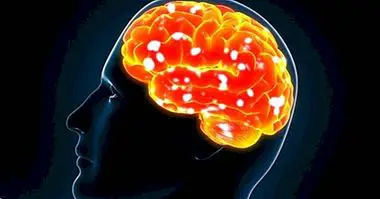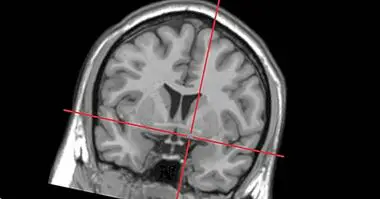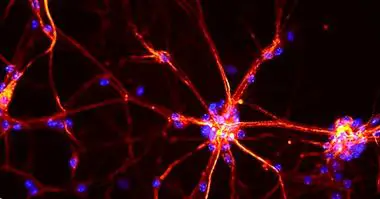Basal ganglia: anatomy and functions
The cerebral cortex is the most visible part of the human brain, as well as the best known. Its division into two hemispheres, as well as four lobes (frontal, parietal, temporal and occipital) has been known and studied since ancient times.
However, the human brain is a complex organ, possessing in its interior different structures and fundamental substructures for the functioning and maintenance of bodily and cognitive functions, participating in a large number of areas. Examples of these parts of the brain are the hippocampus, the limbic system or the set of nuclei discussed in this article, the basal ganglia .
What are the basal ganglia?
We call basal ganglia a set of interconnected subcortical nuclei located around the limbic system and the third ventricle. They are located on both sides of the thalamus, at the height of the temporal lobe. It is gray matter clusters (that is, areas in which the parts of neurons that are not myelinated are concentrated) that have a large number of connections with other areas of the brain, such as the cortex or the thalamus, both at the level of afferents and of eferences (they receive information from other brain areas).
The basal ganglia are distributed between areas near the center of the brain, under the cerebral cortex and around the diencephalon, and because of their location they have a role in actions that are between the automatic and the voluntary.
The main neurotransmitters that act in these brain areas are dopamine as exciter and GABA as an inhibitory component, having different effects depending on the nucleus and the nervous circuits in which they act.
Main components of the basal ganglia
Despite being considered as a set of nuclei given their interconnection, the basal ganglia consist of differentiated substructures and, in fact, physically it is easy to notice the spaces between them. Below you can find the main structures of this set of brain structures:
1. Striated body
The striatum is considered the main area of reception of information of the basal ganglia . That is, it is an area that receives numerous projections from different brain areas, integrating the information and acting with it. It is composed of the neoestriate nucleus (composed of caudate nucleus and putamen), which is primarily responsible for receiving afferents from the nigrostriatal tract, and the lenticular nucleus (made up of putamen and globus pallidus), more focused on sending messages to other nuclei cerebral.
2. Caudate Nucleus
Located below the frontal lobe and in connection with the occipital , this structure is linked to the sensation of alarm, warning that something is not working correctly, as well as motivation. This is due to its connections to the frontal lobe, especially the orbitofrontal cortex.
3. Putamen
Fundamental element in the control of automated movements, Located below the caudate nucleus and united by the anterior zone. It is linked to the movement of the face and extremities .
4. Globus pallidus
Derived from the diencephalon, it is situated between putamen and internal capsule . In this case, it has myelinated neurons that are used to transmit information to the thalamus and the substantia nigra.
5. Black substance
Located under the thalamus, in the trunk of the brain, this structure is known to be one of the main sources of brain dopamine. Actively participates in the brain reward system. In its connection with the striated (forming part of the nigrostria tract) it also has great importance in the control of fine movement, both of extremities and of the eyes.
6. Nucleus accumbens
Located under the globus pallidus, it receives signals from the ventral tegmental area and sends signals to the pale globe . This nucleus participates in the maintenance of behaviors reinforced by drugs and habituation, having connections with the limbic system.
7. subthalamic nucleus
Located at the junction between mesencephalon and thalamus , the main function that is given to the subthalamic nucleus is that of regulating motor functions.
8. Red substance
This structure maintains important connections to the cerebellum and spinal cord l , being especially linked to motor coordination. Specifically, it has special relevance in the control of arms and shoulder.
Functions of the basal ganglia
As it has been observed in the explanation of its components, the functions of the basal ganglia are varied, participating in numerous and important aspects of our life . Making a general review of the aspects in which we participate we can say that some of its main functions are the following:
1. Planning, integration and control of voluntary movement
One of the functions by which the basal ganglia is most known is the regulation and management of voluntary motor actions. Acting through the corticostriatal circuit, they act concretely as an unconscious filter that inhibits or selects the movements to be made , specifically helping to control body posture and coordinate the fine / precise movement of the extremities.
The basal ganglia allow marking the end of a movement, planning sequences and correcting them if needed.
2. Procedural learning
Another aspect in which the basal ganglia they have a predominant performance is in procedural learning and in the automation of behavior . This type of learning is what allows you to get used to performing sequences of actions such as those necessary to drive, play an instrument, shave or sew, allowing the management of attentional resources so that they can be directed towards other tasks.
3. Executive functions
The basal ganglia also participate actively in executive functions . Specifically, it contributes to the maintenance of processing speed, planning at the cognitive level and the elaboration of strategies to solve problems. In the same way, the connections of the basal ganglia with the orbitofrontal cortex cause them to be involved in the capacity of behavioral inhibition.
4. Participation in emotional and motivational behavior
As it mentioned above, some basal ganglia such as the nucleus accumbens have connections with the limbic system and the brain reward system , given its importance in the management of dopamine. Thus, it can be considered that the basal ganglia participate in emotional behavior and reinforcement produced by drugs or stimulation.
For example, basal ganglia play a very important role in both classical conditioning and operant conditioning.
Disorders linked to problems in the basal ganglia
As can be seen, all these elements and functions make the basal ganglia fundamental elements for the correct functioning of the organism.
But..., What happens when there is an injury or an event causes these nuclei do not coordinate or act as they should? In this case we can find some of the following problems and disorders, generally dealing with hypo or hyperkinetic problems, that is, linked to movement.
1. Parkinson
The most common and well-known disorder derived from a malfunction of the basal ganglia is Parkinson's disease. Parkinson's or quiescent tremors are the most recognizable symptoms of this disorder. Also, there is also muscle rigidity and loss of spontaneous movements. together with a marked bradykinesia or loss of motor speed and gait disorders.
This disorder occurs especially in the degeneration and death of the dopaminergic cells of the nigrostriate , which causes the transmission of dopamine to be lost to a great extent, not reaching the information to the motor cortex.
- Related article: "Parkinson: causes, symptoms, treatment and prevention"
2. Huntington's Korea
It is a neurodegenerative genetic disorder caused by an alteration a dominant gene on chromosome number four , with full penetrance. It produces hyperkinetic symptoms: the disease causes uncontrolled movements similar to a dance (hence the name of Korea), and significant loss of executive functions and memory. The deficits are produced mainly by the death of neurons of the caudate nucleus, especially of GABAergic and cholinergic neurons.
3. Syndrome of loss of psychic self-activation
As mentioned previously, the basal ganglia are related to personal motivation. An injury in these areas may therefore have serious implications in this regard , as in the syndrome of loss of psychic self-activation or PAP.
This disorder, also known as pure psychic akinesia or loss of the onset or maintenance of the action, produces extreme passivity in the sufferer, losing the ability to be interested, spontaneity and motivation. Who suffers it is able to recognize their deficits, so that anosognosia is not present, but they show great indifference for them.
4. Disorders due to tics and the Tourette syndrome
In these disorders, such as Tourette's syndrome, which are characterized by the presentation of movements, vocalizations, gestures or very stereotyped behaviors that are performed unconsciously , there is severe involvement of the basal ganglia. More specifically, it is believed that these disorders may be related to problems in the putamen.
5. Other linked disorders
Apart from these disorders, alterations of the basal ganglia usually occur in a large number of psychological problems. For example, in obsessive-compulsive disorder or ADHD can and do appear to be alterations of these brain systems.
Bibliographic references:
- Alexander, G.E .; DeLong, M.R. & Strick, P.L. (1986).Parallel organization of functionally segregated circuits linking basal ganglia and cortex. Annu Rev Neurosci .; 9: 357-381.
- Kandel, E. R. (2001). Principles of Neuroscience. 1st edition. McGraw-Hill.
- Melnick, M.E. (2013). Basal ganglia disorders. In: Umphred DA, Burton GU, Lazaro RT, Roller ML, eds. Umphred's Neurological Rehabilitation. 6th ed. Philadelphia, PA: Elsevier Mosby; chap 20
- Morris, M.E .; Iansek, R., Matyas, T.A. & Summers, J.J. (nineteen ninety six). Stride length regulation in Parkinson's disease. Normalization strategies and underlying mechanisms. Brain. 119: 551-68.

